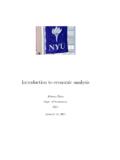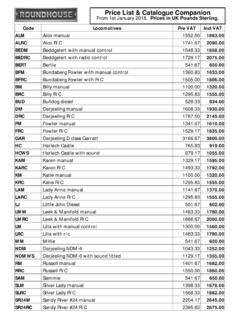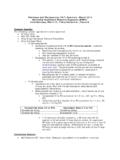Transcription of Guidelines on Clinical Evaluation of Vaccines: …
1 1 2 WHO/DRAFT/27 january 2016 3 ENGLISH ONLY 4 5 6 Guidelines on Clinical Evaluation of Vaccines: regulatory expectations 7 Proposed revision of WHO TRS 924, Annex 1 8 9 NOTE: 10 11 This document has been prepared for the purpose of inviting comments and suggestions on the proposals 12 contained therein, which will then be considered by the Expert Committee on Biological Standardization 13 (ECBS). Publication of this early draft is to provide information about the proposed Guidelines on 14 Clinical Evaluation of Vaccines: regulatory expectations , to a broad audience and to improve 15 transparency of the consultation process. 16 17 The text in its present form does not necessarily represent an agreed formulation of the Expert 18 Committee. Written comments proposing modifications to this text MUST be received by 15th 19 March 2016 in the Comment Form available separately and should be addressed to the World Health 20 Organization, 1211 Geneva 27, Switzerland, attention: Department of Essential Medicines and Health 21 Products (EMP).
2 Comments may also be submitted electronically to the Responsible Officer: Dr Ivana 22 Knezevic at email: 23 24 The outcome of the deliberations of the Expert Committee on Biological Standardization will be 25 published in the WHO Technical Report Series. The final agreed formulation of the document will be 26 edited to be in conformity with the "WHO style guide" (WHO/IMD/ ). 27 28 World Health Organization 2016 29 All rights reserved. Publications of the World Health Organization can be obtained from WHO Press, World Health 30 Organization, 20 Avenue Appia, 1211 Geneva 27, Switzerland (tel.: +41 22 791 3264; fax: +41 22 791 4857; e-mail: 31 Requests for permission to reproduce or translate WHO publications whether for sale or for non-32 commercial distribution should be addressed to WHO Press, at the above address (fax: +41 22 791 4806; e-mail: 33 34 The designations employed and the presentation of the material in this publication do not imply the expression of any 35 opinion whatsoever on the part of the World Health Organization concerning the legal status of any country, territory, city or 36 WHO/DRAFT/27 january 2016 Page 2 area or of its authorities, or concerning the delimitation of its frontiers or boundaries.))
3 Dotted lines on maps represent 37 approximate border lines for which there may not yet be full agreement. 38 39 The mention of specific companies or of certain manufacturers products does not imply that they are endorsed or 40 recommended by the World Health Organization in preference to others of a similar nature that are not mentioned. Errors 41 and omissions excepted, the names of proprietary products are distinguished by initial capital letters. 42 43 All reasonable precautions have been taken by the World Health Organization to verify the information contained in this 44 publication. However, the published material is being distributed without warranty of any kind, either expressed or implied. 45 The responsibility for the interpretation and use of the material lies with the reader. In no event shall the World Health 46 Organization be liable for damages arising from its use.
4 47 48 The named authors [or editors as appropriate] alone are responsible for the views expressed in this publication. 49 50 51 52 53 54 Recommendations and Guidelines published by WHO are intended to be scientific and advisory in nature. Each of the following sections constitutes guidance for national regulatory authorities (NRAs) and for manufacturers of biological products. If an NRA so desires, these Guidelines may be adopted as definitive national requirements, or modifications may be justified and made by the NRA. It is recommended that modifications to these Guidelines be made only on condition that modifications ensure that the vaccine is at least as safe and efficacious as that prepared in accordance with the recommendations set out below. The parts of each section printed in small type are comments or examples for additional guidance intended for manufacturers and NRAs, which may benefit from those details.
5 WHO/DRAFT/27 january 2016 Page 3 Table of Contents 55 56 1. Introduction 57 2. Scope 58 3. Glossary 59 4. vaccine Clinical Development Programs 60 General considerations 61 Consultation with National regulatory Authorities (NRAs) 62 Use of independent data monitoring committees 63 Registering and reporting Clinical trials 64 New candidate vaccines 65 Safety and immunogenicity trials 66 Initial trials 67 Further trials 68 Confirmatory (or pivotal) trials 69 Efficacy trials 70 Pivotal safety trials 71 Post-licensure Clinical evaluations 72 5. Immunogenicity 73 General considerations 74 Characterization of the immune response 75 Measuring the immune response 76 Collection of specimens 77 Immunological parameters 78 Humoral immune response 79 Cell-mediated immune response 80 Assays 81 Determination and use of immunological correlates of protection 82 Immunological correlates of protection and their uses 83 Establishing an ICP 84 Immunogenicity trials 85 WHO/DRAFT/27 january 2016 Page 4 Objectives 86 General considerations for trial designs 87 Endpoints 88 Exploratory trials 89 Superiority trials 90 Non-inferiority trials 91 Analysis and interpretation 92 Specific considerations for trial design and interpretation 93 Selection of formulation and posology 94 Selecting the formulation and posology for initial licensure 95
6 Amending or adding posologies after initial licensure 96 Post-primary doses 97 Using immunogenicity data to predict efficacy 98 Bridging to efficacy data 99 Other approaches 100 Co-administration trials 101 Immunization of pregnant women 102 Dose-finding in pregnancy 103 Aims of immunization during pregnancy 104 Passive protection of infants 105 Changes to the manufacturing process 106 Lot-to-lot consistency trials 107 6. Efficacy and effectiveness 108 Approaches to determination of efficacy 109 Human challenge trials 110 Preliminary efficacy trials 111 Confirmatory (pivotal) efficacy trials 112 Design and conduct of efficacy trials 113 Selection of trial sites 114 Candidate (test) vaccine group(s) 115 Control (reference) group(s) 116 WHO/DRAFT/27 january 2016 Page 5 Control groups not vaccinated against the infectious disease to be 117 prevented 118 Control groups vaccinated against the infectious disease to be 119 prevented 120 Trial designs 121 Randomization 122 Types of trial design 123 Clinical endpoints 124 Primary endpoints 125 Secondary endpoints 126 Case definition 127 Case ascertainment 128 Statistical considerations 129 Sample size 130 Analysis populations 131 Primary analysis 132 Other analyses 133 Other issues 134 Approaches to determination of effectiveness 135 7.
7 Safety 136 General considerations 137 Assessment of safety in Clinical trials 138 Safety as a primary or secondary endpoint 139 Safety as a primary endpoint 140 Safety as a secondary endpoint 141 Recording and reporting adverse events 142 Methods 143 Solicited signs and symptoms 144 Unsolicited AEFIs 145 Other investigations 146 Categorization of adverse events 147 WHO/DRAFT/27 january 2016 Page 6 Causality 148 Severity 149 Other categorisation 150 AE reporting rates within and between trials 151 Size of the pre-licensure safety database 152 Post-licensure safety surveillance 153 154 Authors and Acknowledgements 155 References 156 Appendix 1. Human challenge trials 157 158 WHO/DRAFT/27 january 2016 Page 7 1. Introduction 159 160 This guideline is intended to replace WHO Technical Report, Series No. 924, Annex 1 Guidelines 161 on Clinical Evaluation of vaccines: regulatory expectations , which was adopted by the Expert 162 Committee on Biological Standardization (ECBS) in 2001 (1).
8 This document of 2001 has 163 served as a basis for setting or updating national requirements for the Evaluation and licensing of 164 a broad range of vaccines as well as for WHO vaccine prequalification. 165 166 Following on the establishment of the document of 2001, more than 20 vaccine -specific 167 documents that include a section on Clinical Evaluation have been adopted by the ECBS, all of 168 which are intended to be read in conjunction with TRS 924, Annex 1 (2). These include 169 documents that address polio vaccines [OPV, IPV], whole cell pertussis and acellular pertussis 170 vaccines, meningococcal conjugate vaccines for serotypes A and C, pneumococcal conjugate 171 vaccines and vaccines intended to prevent diseases due to rotaviruses, dengue viruses, human 172 papillomaviruses and malaria parasites.
9 173 174 This guideline has been prepared to reflect the scientific and regulatory experience that has been 175 gained from vaccine Clinical development programs since the adoption of the above mentioned 176 version in 2001. Many challenging issues surrounding appropriate and feasible vaccine Clinical 177 development programs for specific types of vaccines have arisen in the intervening period. For 178 example, there has been increasing recognition of the potential need to base initial licensure of 179 certain vaccines on safety and immunogenicity data only ( it is not feasible to generate pre-180 licensure efficacy data) and in the absence of an established immunological correlate of 181 protection (ICP). 182 183 This guideline is intended for use by national regulatory authorities (NRAs), companies 184 developing and holding licences for vaccines, Clinical researchers and investigators.
10 It considers 185 the variable content of Clinical development programs, Clinical trial designs, the interpretation of 186 trial results and post-licensing activities. The content of the various sections is intended to assist 187 in the preparation and approval of Clinical trial applications, applications for initial licensure and 188 WHO/DRAFT/27 january 2016 Page 8 applications to support post-licensure changes as well as to provide guidance on post-licensure 189 activities, such as pharmacovigilance and estimation of vaccine effectiveness. 190 191 The main changes (modification or expansion of previous text and additional issues covered) in 192 this revision compared to the above mentioned version of TRS No. 924, Annex 1, 2001 (1) 193 include, but are not limited to, the following: 194 195 Immunogenicity 196 General principles for comparative immunogenicity studies, including selection of the 197 comparators, endpoints and acceptance criteria for concluding non-inferiority or 198 superiority of immune responses 199 Situations in which age de-escalation studies may be inappropriate 200 Assessing the need for and timing of post-primary doses 201 Using different vaccines for priming and boosting 202 Assessing the ability of vaccines to elicit immune memory or to cause hypo-203 responsiveness 204 Using immunogenicity data to predict vaccine efficacy.














